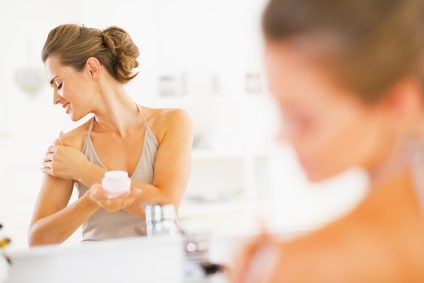Topical Antioxidants Help Protect the Skin from Sun Damage
Posted by Katie Zapotoczny on 6th Jun 2015

Summer is here, and as the days warm up, you may be thinking more about how to protect your skin from the sun. Sunscreen is probably the best-known method of preventing sunburns, but there are additional ways to protect your skin from sun damage. Before looking at “sun safety,” let’s learn a little bit about how UV rays affect the skin.
The Effects of the Sun’s Rays
There are two types of solar radiation that tend to do the most harm: ultraviolet A (UVA) and ultraviolet B (UVB) rays. UVA and UVB rays behave differently and affect the skin in various ways. UVA rays are equally intense throughout the year and can pass through glass and clouds. These rays affect the deep layers of the skin (source). In contrast, UVB rays are most intense here in the U.S. between 10:00 a.m. and 4:00 p.m. from April through October. But they can also cause skin damage in the winter, especially at high altitudes and in areas with snow and ice, which reflect the rays. Window glass can filter out most UVB rays. These rays affect the outer layers of the skin and cause sunburns (source).
Ultraviolet rays can create free radicals, which do serious harm to skin cells over time. They can damage DNA as well as collagen and elastin, the proteins that give the skin its structure and its “springiness,” respectively. Excessive time in the sun without sunscreen or protective clothing can cause collagen to break down (source). The sun’s rays can also dry out the fats that keep the skin moisturized. Damage caused by repeated, long-term sun exposure can speed the appearance of age-related wrinkles and thin, sagging skin and is also associated with the development of skin cancer (source).
Preventing Sun Damage
The sun can do a lot of damage to our skin, but the good news is that there are quite a few things we can do to help prevent and repair this damage. Wearing sunscreen and protective clothing is important. And skin care products that contain antioxidants and beneficial fatty acids have been shown to mitigate the effects of the sun too. Antioxidants are critical for helping to prevent and heal the damage that free radicals cause. Studies have found that, while consuming high-antioxidant foods delivers them internally, applying antioxidants topically is the most effective way to increase these essential compounds in the skin (source). Antioxidants within the skin are depleted during times of sun exposure, but they can (and should) be replaced with topical formulas. Here are a few antioxidants and beneficial plant oils and extracts to look for in skin care products:
Coenzyme Q10 (CoQ10)- CoQ10 is a natural antioxidant that helps cells to grow. The body’s ability to make CoQ10 decreases with age, so applying it topically can help replenish the skin’s supply of it. More studies on CoQ10 are needed, but there is some evidence that topical use of it may help minimize the appearance of wrinkles (source). CoQ10 is found in Verefina’s Antioxidant Eye Balm.
Sea Buckthorn Oil- This oil is high in vitamins A, C, and E and the minerals zinc, sulfur, selenium, and copper. It is also a good source of antioxidant carotenes and flavonoids. Sea buckthorn oil contains omega fatty acids 3, 6, and 7 as well. Omega 3’s and 6’s help protect against sun damage and support the body’s production of collagen and elastin (source). Sea buckthorn oil is found in Verefina’s Sea Buckthorn Facial Cream.
Pomegranate Seed Extract- Pomegrantes are high in vitamins C and E, fatty acids, and ellagic acid, a potent antioxidant (source). Whether consumed or applied topically, pomegranate extract can help with the prevention and treatment of sunburn. Studies have found that ellagic acid inhibited sunburn in young women (source). Pomegranate seed extract is oil is found in Verefina’s Sea Buckthorn Facial Cream.
Aloe Juice- Aloe is rich in antioxidants, including vitamins C and E and beta carotene. These nutrients can help keep skin firm and hydrated. Aloe is also well-known for its ability to heal sunburns. Aloe helps to restore moisture to sunburned skin, and its antioxidants aid in speeding the healing process (source). Aloe is found in Verefina’s Aloe and Calendula Cream, Sea Buckthorn Facial Cream, and Lemon Coconut Creamy Facial Cleanser.
Sun exposure can damage the skin over time. However, topical antioxidants help to prevent and repair this damage. Many of Verefina’s products contain these healing antioxidants, making them an important part of your sun protection routine.
Sources:
“Adding Antioxidants to a Sun Protection Plan.” University of Cincinnati. 3 April 2014. Web. 16 May 2015.
http://healthnews.uc.edu/news/?/24252/
“Pomegranate.” Truth in Aging. 24 April 2013. Web. 16 May 2015.
https://www.truthinaging.com/review/pomegranate-2
Rocchino, Elizabeth. “The Benefits of Using Aloe Vera for Skin Care and More.” MindBodyGreen. 7 February 2013. Web. 15 May 2015.
http://www.mindbodygreen.com/0-7654/the-benefits-o...
“Sea Buckthorn, The Age-Defying Wonder.” Organic Spa Magazine. 29 April 2012. Web 16 May 2015.
http://www.organicspamagazine.com/sea-buckthorn-th...
“Skin Wrinkles and Blemishes.” University of Maryland Medical Center. 18 September 2013. Web. 16 May 2015.
http://umm.edu/health/medical/reports/articles/ski...
Watson, Stephanie. “Skin Care Vitamins and Antioxidants.” WebMD. Web 16 May 2015.
http://www.webmd.com/vitamins-and-supplements/life...
Photo courtesy of Verefina
 About the Author
About the Author
Katie Zapotoczny is a Verefina Affiliate and the creator of An Ever Green Life, a blog that seeks to empower readers to make changes that will improve their health and help protect our environment.

